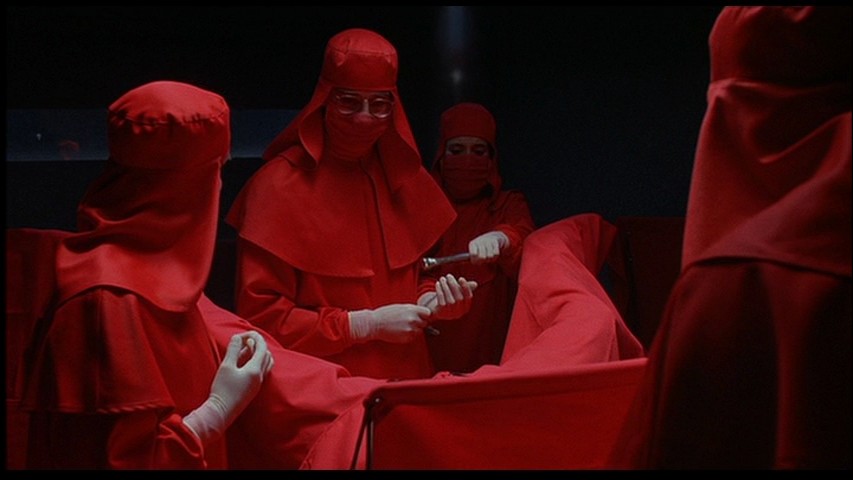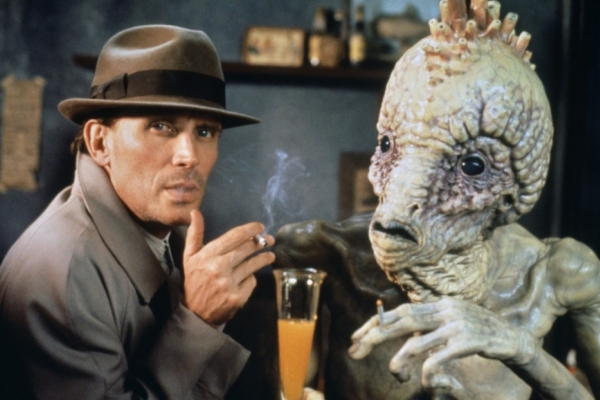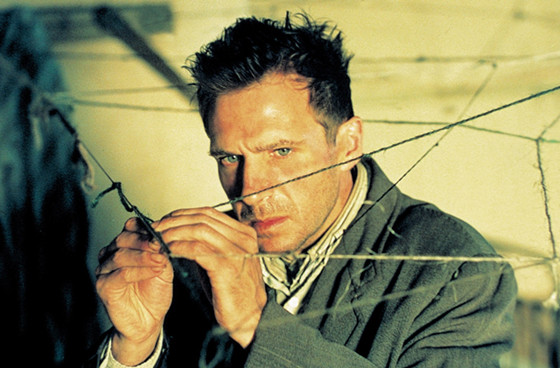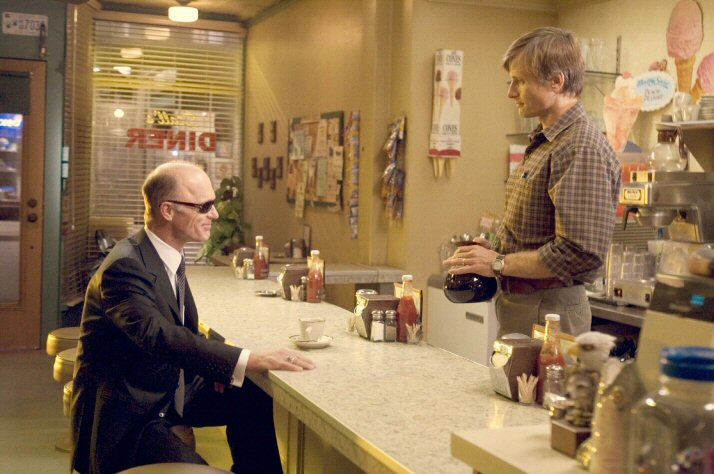6. Dead Ringers (1988)

Dead Ringers followed Cronenberg’s 1886 hit remake The Fly. Rather than follow the smash-hit with another commercial monster movie, he dived head-first into a troubling tale of sex, obsession, and madness which would affect the rest of his career.
Elliot and Beverly are identical twins, both played masterfully by Jeremy Irons. Both own and operate an up-market and prestigious private gynaecology practice. They live their life together, sharing everything, even women. Elliot is the more confident twin, he is charming and extroverted, Beverly is more reserved and introverted. Elliot seduces his more beautiful patients, and when he tires of them he passes them on to Beverly, with the women non the wiser.
When a beautiful and famous actress, Claire, comes to the clinic to be treated for a rare condition, a trifurcated cervix, Elliot cannot resist seducing her, but when he passes her to Beverly an unimaginable rift grows between them. Beverly falls into an obsessive love with Claire, even joining her in her abuse of prescription drugs.
Claire eventually discovers that she had been seeing both twins, and although she is angered by the deception, she continues her relationship with Beverly exclusively, who becomes more and more dependent on both her and the drugs. When Claire must leave to work on a film, Beverly spirals into a depression, fuelled by drugs and increasing paranoia, he begins to have delusions of mutating women, with devastating results for the once inseparable brothers.
With Dead Ringers, Cronenberg introduces a theme which will continue to reoccur in his work: a move from the fragility of the flesh to fragility of the mind.
7. Naked Lunch (1991)

With Naked Lunch, Cronenberg set out to achieve the impossible: to adapt one of the most un-adaptable works of literature to film. William S. Burroughs’ manic and hallucinogenic opus Naked Lunch caused waves that continues to be felt to this day. With its gruesome humour, its violent sexuality, its graphic descriptions of mutating flesh and viscera, its contempt for self-censorship: only Cronenberg could have done it justice.
Rather than attempting to adapt the novel directly, which would have resulted in an unimaginably expensive film no one but the most dedicated Burroughs readers would ever dare see, Cronenberg opted to tell a fantasised origin story of the book itself. Drawing from other Burroughs works, not only Naked Lunch, it tells the story of a reluctant writer, Bill Lee (a stand-in for Burroughs himself) working as a bug exterminator. When his wife Joan becomes addicted to shooting-up the bug powder he uses to kill roaches and bedbugs, he too takes up the habit.
One day as he dozes, his typewriter turns into a beetle with a talking anus on its abdomen. The beetle informs him that he is a secret agent involved in a shadowy conspiracy, and instructs him to kill Joan, claiming she is an enemy agent. Rejecting what he considers a hallucination, he seeks help for Joan’s and his own bug powder habit from the sinister Dr Benway, who prescribes the black power of the giant aquatic Brazilian centipede, a cure which will become a habit itself.
When he seemingly accidentally shoots his wife in the head during a “William Tell” routine (in a scene echoing the real-life death of Burroughs’ wife by his own hand), Bill goes on the run. He flees into the Interzone: a paranoid and hallucinogenic country of the mind, occupied by neurotic writers and their insectoid typewriters, call-boys, dealers of exotic drugs, and the reptilian-humanoid Mugwumps and their addictive semen.
Naked Lunch is a masterful piece of cinema to be experienced, not described. It takes us off of the pages and into the murky, paranoid, and labyrinthine mind of the writer himself.
8. Crash (1996)

With Crash, Cronenberg again adapts a work of fiction from one of his greatest influences, J.G. Ballard, author of High-Rise, Empire of the Sun, and The Atrocity Exhibition.
Crash deals with many of the same themes that Cronenberg relishes in, but this time the new flesh is the motor car, and the motor crash the new sex. James Ballard and his wife Catherine are in an open marriage, compulsively having sex with strangers and comparing notes.
James enters a relationship with new woman, Helen Remington, after crashing into her car and accidentally killing her husband. Aroused by their shared experience, they plunge into a paraphilic* underground culture where people watch movies of car crashes, have sex in cars, and recreate famous celebrity car crashes.
When do the objects we use become extensions of our body? Most of us might find it absurd to call a car an extension of our sexual existence, but the motor car was essential in defining a new age of sexual freedom. As technology integrates more and more with our everyday functions, is it so far-fetched to conclude that cars, computers,mobile phones, artificial body parts, or virtual and augmented realities might one day be as inseparable from our sexuality as our desires themselves?
*A condition of experiencing sexual arousal from atypical objects, individuals, or situations.
9. Spider (2002)

In a dingy industrial area of London, Dennis Cleg, also known as Spider, wanders alone and withdrawn. Suffering from schizophrenia, he mutters to himself constantly, and scrawls long lines of his own private language into a secret notebook. Released from a mental institution in the countryside, he has retuned to London to live in a halfway house for people like himself, but the familiar streets do not ease his paranoia.
As he roams under the bridges and through the empty lots of his troubled childhood, he begins to see his past, observing unseen his parents’ relationship falling apart, his fathers infidelity, and the beginnings of his first-weaved webs of paranoia and delusion, leading to the tragedy that made the young Dennis Cleg into Spider.
Spider was a labour of love for both Cronenberg and his lead, award winning actor Ralph Fiennes. Both took no pay for the production itself, so dedicated were they to making the film, and making it right. And make it right they did. Based on the original novel and screenplay by the same author Patrick McGrath, with Spider Cronenberg weaves a masterful portrait of a broken mind.
10. A History of Violence (2005)

At first glance, A History of Violence might look like a standard thriller. Tom Stall is a seemingly average husband and father in an average small town. When armed robbers burst into a local restaurant and threaten the life of a waitress, something unexpected happens: Tom kills the two robbers with swift and deadly skill that no average man is supposed to possess.
The violent but heroic incident makes him a town hero, a fame he is clearly uncomfortable with. It isn’t long before he is visited by a scarred, intimidating gangster named Carl Fogarty, an Irish mobster from Philadelphia, who claims Tom is in fact Joey Cusack, one of their number. With his new life and family threatened, Tom Stall must reach into the darkness of his past and awaken Joey Cusak one last time.
In A History of Violence Cronenberg is cutting strait to the viscera of violence itself. There are no insidious medical conspiracies here, no mutations of the flesh: only the volatile capacity for violence that sleeps inside us, awaiting a trigger. What makes A History of Violence a quintessential Cronenberg film is its evocation of the primitive forces that lurk in the darkness behind the veneer of culture and civility, waiting to break though.
At the core of all of Cronenberg’s work one question is asked again and again: is the flesh the puppet of the mind, or is the mind the puppet of the flesh?
Author Bio: Benjamin Pahl Robinson is a film-maker based in Australia and Argentina. He works in both drama and documentary.